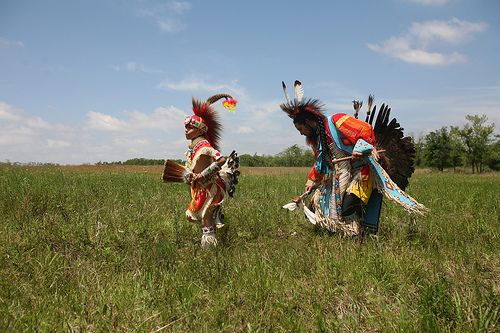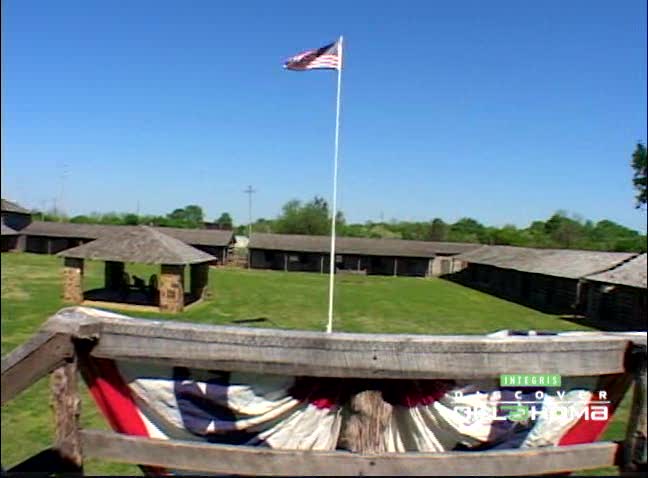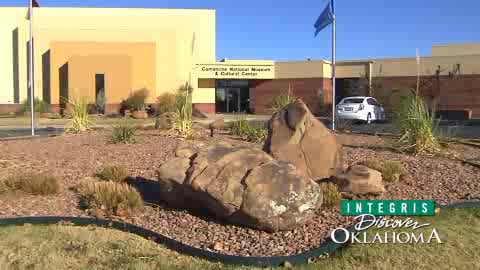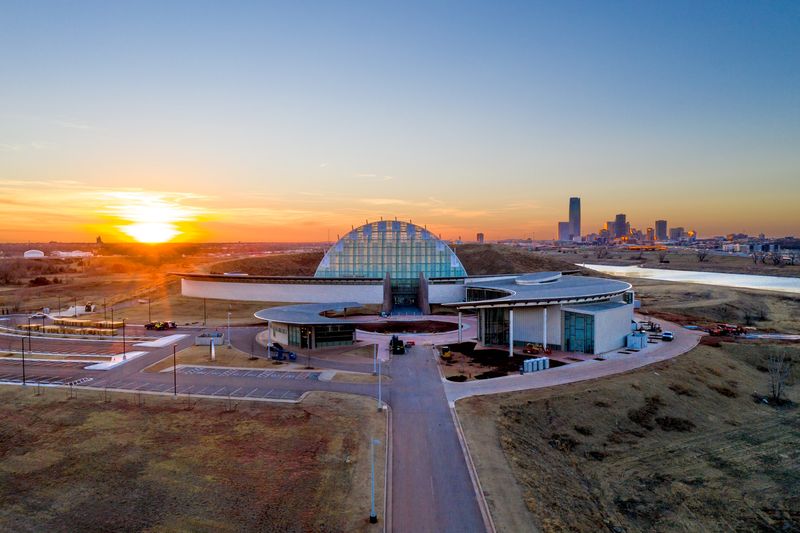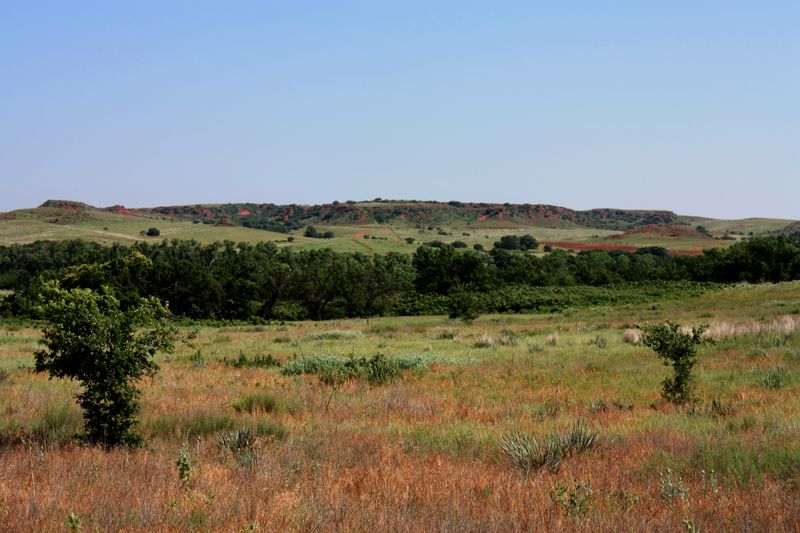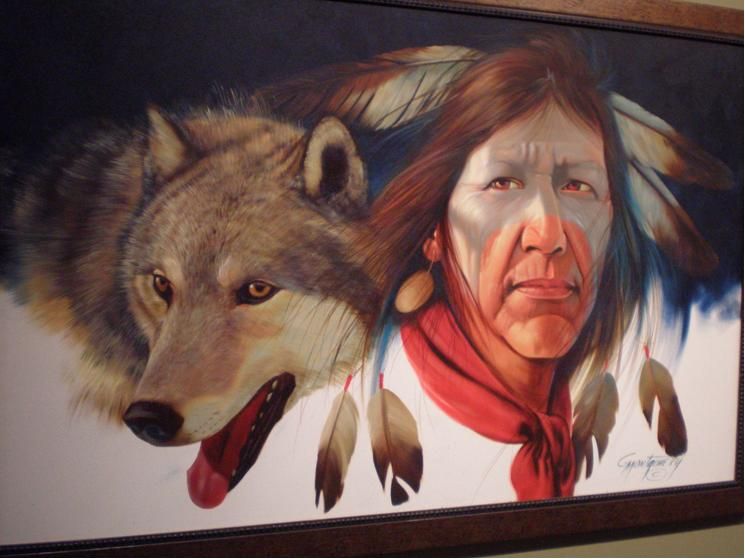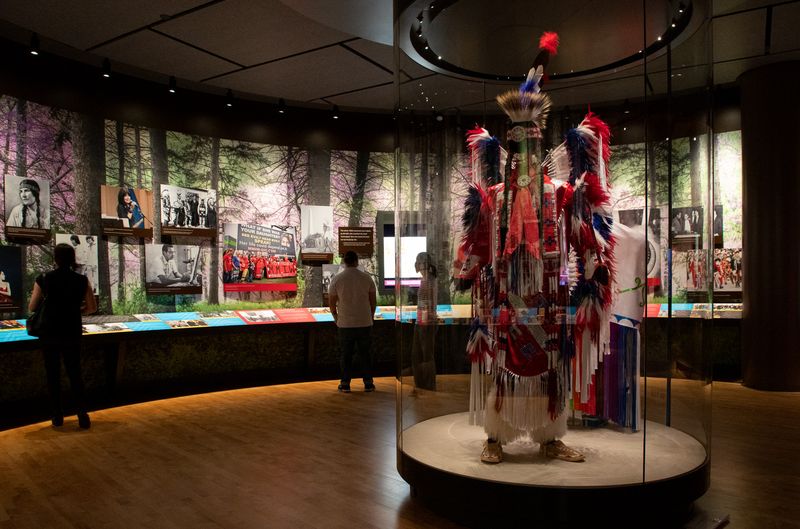A total of 67 tribal nations have called Oklahoma home, creating a captivating blend of cultures. While many of those tribes were relocated to Oklahoma in the 19th century, the state’s rich American Indian history extends back in time 30,000 years. This brief overview provides a glimpse into the history of this land which has played host to an ancient network that governed much of the continent as well as a continuum of cultures into the present.
Pre-1492 | Prehistory
The culture of Oklahoma’s Native peoples is an ancient one, and museums throughout Oklahoma reveal fascinating details about the earliest Oklahoma inhabitants. The Sam Noble Museum has one of the most comprehensive exhibits on Oklahoma’s prehistoric peoples including the oldest known painted object in North America – the Cooper Skull. The 10,000-year-old artifact features a red zig-zag pattern painted on the skull of a now-extinct species of bison. A holographic presentation near the Cooper Skull transports museum visitors to the box canyon in northern Oklahoma where bison kills took place and where the artifact was discovered.
The Spiro Mounds Archaeological Center in southeastern Oklahoma is another important site helping today’s society discover Oklahoma’s prehistoric culture. Spiro Mounds is the only prehistoric Native American archaeological site open to the public in Oklahoma. Home to rich cultural resources, the Spiro Mounds were created and used by Caddoan-speaking American Indians between 850 and 1450 AD. The area became the seat of power of the ancient Mississippian culture which created an extensive trade network, a working political system and a highly developed religious center.
Dubbed the "King Tut of the Arkansas Valley" in 1935, the Spiro Mounds have yielded elaborate ceremonial grave goods including basketry, feather capes and cloth. Artifacts from this site are located in museums around the globe including the Smithsonian Institution in Washington, D.C. The on-site museum is filled with antiquities excavated from the mounds and interpretive displays to help visitors understand this fascinating culture. Visitors to the Spiro Mounds will discover nearly two miles of interpretive trails and a staff archaeologist to answer questions and lead tours.
1492-1828 | Colonial Period
For the most part, European-American expansion had little impact on the area we now know as Oklahoma during this period. However, in 1824 the U.S. government established Oklahoma’s oldest frontier fort, Fort Gibson, signaling that change was on the way.
Fort Gibson kept the peace in Indian Territory, which included negotiating peace among the tribes in the area and keeping white settlers from encroaching on the lands of the tribes. It served as a starting point for several military expeditions exploring the American West and housed troops during several wars including the Civil War.
The Fort Gibson Historic Site and Interpretive Center is a National Historic Landmark, Official National Trail of Tears Site and a designated 'American Treasure' featuring 80 acres of grounds, 29 historic buildings, numerous archaeological ruins and living history programs relating to the settlement of Indian Territory.
1828-1887 | Removal, Reservation and Treaty Period
During this time period, the Indian Wars took place and the U.S. government forced eastern tribes to move west, resulting in the removal of tens of thousands from their homelands onto reservations and many tragic conflicts on the western frontier. Sixty-seven tribes ended up in Indian Territory, which later became the state of Oklahoma.
When American Indians refused to relocate to their appointed reservations or left the reservations to resume their traditional lifestyle they were often met with military force. The Washita Battlefield National Historic Site preserves the history of one such tragic encounter where Lt. Col. George A. Custer’s troops conducted a surprise attack at dawn on the southern Cheyenne village of Peace Chief Black Kettle. The park's visitor center features exhibits, a bookstore and a 27-minute film, Destiny at Dawn, which helps explain the tragedy. Park ranger-led talks are available at the historic site's overlook and a 1.5-mile self-guided trail is also available to visitors.
Several museums throughout the state tell the story of forced removal to Indian Territory, and the Chickasaw Cultural Center in Sulphur is a fascinating choice to learn more about this time period. The Removal Corridor exhibit hall features an outstanding interactive experience narrating the forced removal of the Chickasaw people from their original homeland to Indian Territory.
1887-1934 | Allotment and Assimilation Period
The General Allotment Act of 1887, also known as the Dawes Act, allotted individual land parcels to tribal members in Oklahoma and put an end to communal land ownership. More than 90 million acres of tribal lands that were left over after the individual allotments had been made were seized from American Indian nations and declared surplus in order to open them to white settlers. In Oklahoma, a series of land runs were held allowing settlers to race into the areas that had been declared surplus and stake a claim on the land.
Many of the tribal nations headquartered in Oklahoma today offer cultural centers and museums that convey the intense, personal stories from this very difficult period. Consider a visit to the Citizen Potawatomi Nation Cultural Heritage Center in Shawnee, the Seminole Nation Museum in Wewoka, the Comanche National Museum and Cultural Center in Lawton and the Choctaw Nation Museum in Tuskahoma. You can also learn about the land runs and pioneers who entered Oklahoma at several museums such as the Cherokee Strip Regional Heritage Center in Enid, the Cherokee Strip Museum and Rose Hill School in Perry and the Cherokee Strip Museum in Alva.
1934-1945 | Indian Reorganization Period
The Indian Reorganization Act of 1934 gave many Oklahoma Native American tribes a foothold to begin recovery. The Act ended individual allotments and Federal boarding schools, returned to American Indian nations some of the lands lost since 1887 and authorized tribal self-government.
1945-1968 | Termination Period
Congress decided federal recognition and assistance to more than 100 tribal governments should be terminated, including several Oklahoma tribes. Millions of acres of valuable land rich in natural resources were lost through tax forfeiture sales and federal policy emphasizing the physical relocation of American Indians from reservations to urban areas.
1968-Present | Self-Determination Period
From the Removal Period through today, some 28 tribes left Oklahoma and returned to their homelands, while others joined fragments of their tribes in other parts of the country. A policy of self-governance emerged that favored restoring tribal sovereignty. With control over their lands and resources, many tribes are making great economic strides and reviving their unique cultures and experiencing a renaissance in tribal life.
The Oklahoma History Center and First Americans Museum in Oklahoma City use the 20th-century American Indian experience as a bridge between the past and the present, offering artifacts, tribal music, photographic images, American Indian art and oral histories to provide an overview of Native American history in Oklahoma. Opened in 2021, the FAM shares the collective diversity, history and contributions of the First Americans, allowing visitors to experience the collective histories of 39 distinctive First American Nations in Oklahoma today.









